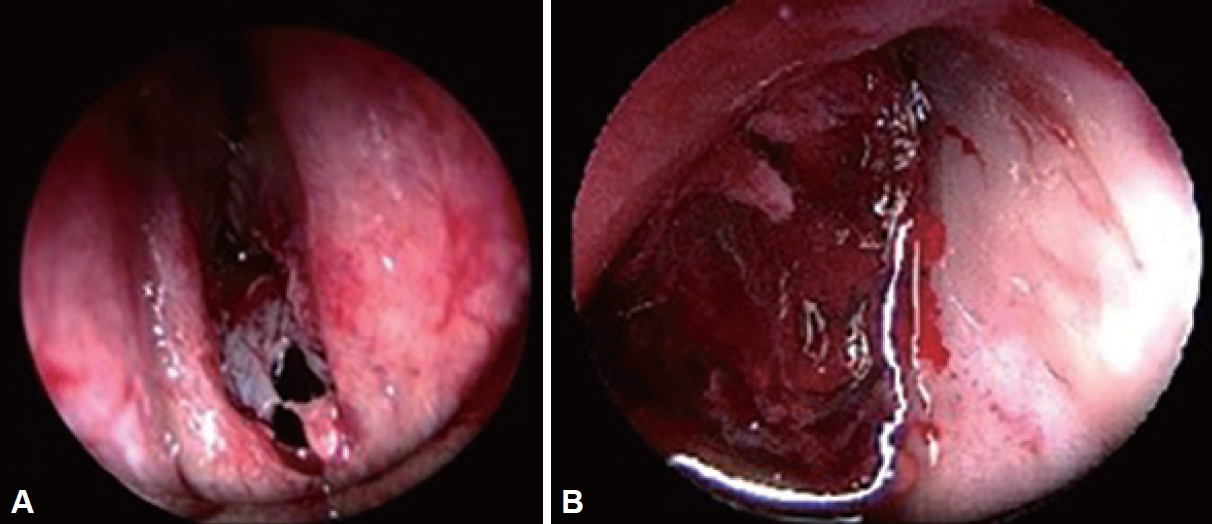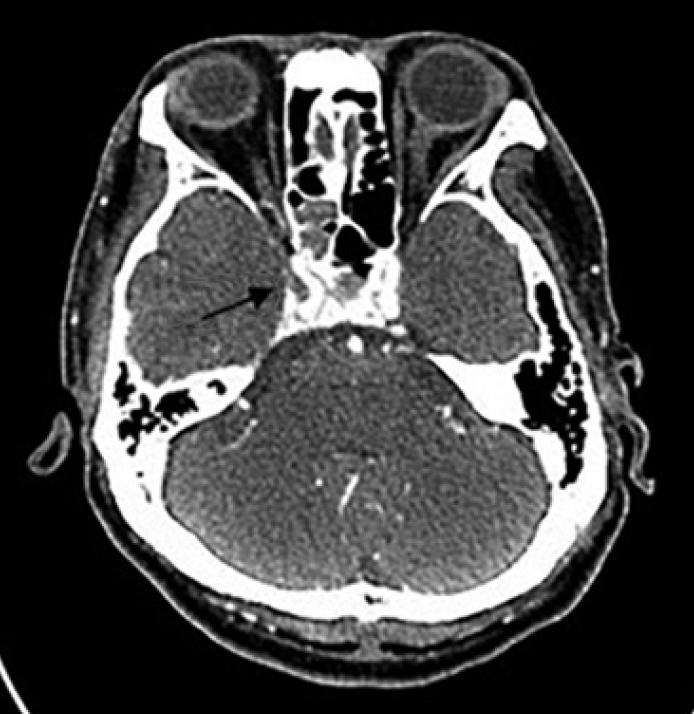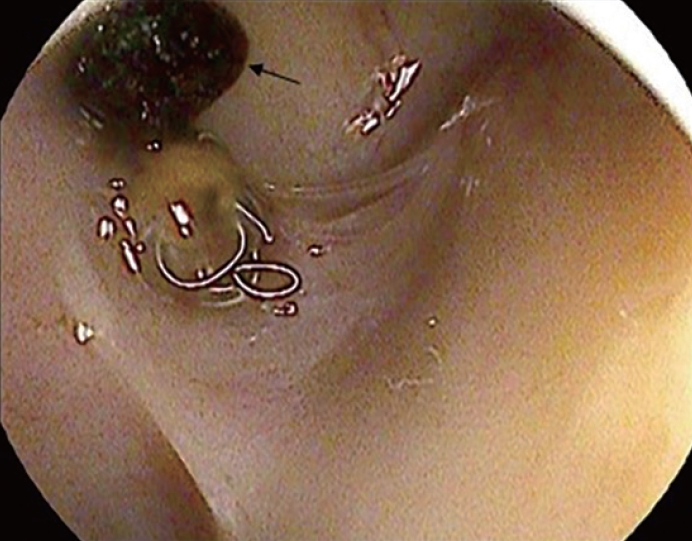 |
 |
| J Rhinol > Volume 31(1); 2024 |
|
Abstract
Traumatic pseudoaneurysms are uncommon vascular lesions that can result from traumatic injuries to the nasal and facial areas. They pose a significant clinical challenge due to their potential to cause recurrent and life-threatening epistaxis. Understanding the underlying vascular anatomy, causes, and treatment options is essential for optimizing patient outcomes. In this case report, we present a 55-year-old man who developed a traumatic pseudoaneurysm of the sphenoid sinus, arising from the cavernous segment of the internal carotid artery following a traumatic incident. This case was successfully managed with stent-assisted coil embolization.
Traumatic pseudoaneurysms, which are uncommon vascular lesions arising from traumatic injuries to the nasal and facial areas [1], pose a significant clinical challenge due to their potential to cause recurrent and life-threatening epistaxis [2]. Pseudoaneurysms develop due to direct arterial injury, leading to a hematoma within the adjacent tissues [3]. Although uncommon, traumatic sphenoid sinus pseudoaneurysms originating from the cavernous segment of the internal carotid artery require immediate recognition and proper management to avert serious complications. Understanding the underlying vascular anatomy, causes, and treatment options is essential for optimizing patient outcomes.
In this case report, we present a 55-year-old man who developed a traumatic sphenoid sinus pseudoaneurysm originating from the cavernous segment of the internal carotid artery following a traumatic incident on April 10, 2023. The patient experienced recurrent and persistent epistaxis, which necessitated emergent medical intervention. This led to the successful treatment of the pseudoaneurysm through stent-assisted coil embolization.
A 55-year-old man presented to the emergency department on May 10, 2023, with a history of recurrent epistaxis following an incident involving a wire on April 10, 2023 (i.e., 31 days prior). The patient had a history of acute cerebral infarction, which occurred after the trauma, but no other significant past medical history was reported. He described the trauma as an incident where a wire penetrated his nose. After the initial trauma, the patient had experienced repeated episodes of nasal bleeding. The traumatic event, which occurred approximately one month earlier, caused persistent discomfort and intermittent episodes of bleeding.
Upon examination, the patient’s medical history revealed no previous episodes of epistaxis or significant nasal symptoms. The patient’s vital signs were stable, indicating no signs of an acute event. The initial laboratory findings showed a hemoglobin level of 7.5 g/dL, prompting a consultation with the hematology/oncology department to evaluate the finding of anemia. Nasal endoscopy revealed active bleeding from the posterior nasal region, which raised concerns about potential underlying vascular issues. Initial attempts to control the bleeding with conservative measures, such as nasal packing, were unsuccessful.
The patient’s persistent and recurrent epistaxis necessitated further management. The patient underwent an emergency operation 31 days after a traumatic event. During the operation, a pulsating soft tissue mass, suspicious for a pseudoaneurysm, was observed within the sphenoid sinus, arising from the posterior wall (Fig. 1). The operation was concluded upon identification of the pulsating mass, and a radiologic evaluation was planned. During the postoperative observation period, there was no evidence of cerebrospinal fluid rhinorrhea. Urgent computed tomography angiography (CTA) of the carotid arteries was performed to assess the vascular structures (Fig. 2). CTA revealed a pseudoaneurysm originating from the cavernous segment of the internal carotid artery near the trauma site (Supplementary Video 1 in the online-only Data Supplement). This pseudoaneurysm was considered the likely cause of the recurrent bleeding episodes. Given the high risk of complications associated with the pseudoaneurysm, a multidisciplinary team—including otolaryngologists and neurosurgeons—convened to discuss the optimal treatment strategy. Taking into account the patient’s clinical presentation, the team decided to perform stent-assisted coil embolization to address the pseudoaneurysm and prevent further bleeding.
Thirty-two days after the traumatic event, the patient underwent stent-assisted coil embolization of a pseudoaneurysm originating from the cavernous segment of the internal carotid artery (Fig. 3). This procedure was carried out under local anesthesia with image guidance. A microcatheter was guided to the pseudoaneurysm, and a stent was meticulously placed to facilitate the coil embolization. The intervention was successful in securing hemostasis and precluding further active bleeding.
After the procedure, the patient was closely monitored in the intensive care unit. He experienced no immediate complications and reported a resolution of the recurrent epistaxis. Follow-up imaging confirmed the successful embolization of the pseudoaneurysm, with no evidence of residual or recurrent bleeding.
In the weeks following treatment, the patient’s condition stabilized, and there was no recurrence of epistaxis. Consequently, he was discharged from the hospital. Six months later, the patient visited an outpatient clinic, reporting no complications or recurrence of symptoms. Nasal endoscopy revealed a coil within the sphenoid sinus (Fig. 4). Further evaluation determined that the cause of the patient’s anemia was recurrent nasal bleeding. His hemoglobin levels returned to normal, measuring 13.4 g/dL.
The presented case underscores the importance of timely intervention for pseudoaneurysms that develop after traumatic events [1]. Pseudoaneurysms arise from direct arterial injury, leading to a hematoma within the adjacent tissues [3]. The patient’s initial trauma, caused by an incident involving a wire, led to ongoing discomfort and repeated episodes of epistaxis [2]. Despite initial conservative management strategies, such as nasal packing, the patient’s symptoms persisted, necessitating further evaluation.
Radiological imaging, including CTA, played a crucial role in confirming the diagnosis of a traumatic sphenoid sinus pseudoaneurysm originating from the cavernous segment of the internal carotid artery [4,5]. The occurrence of a pseudoaneurysm in the sphenoid sinus from the cavernous segment of the internal carotid artery is very rare [6,7]. The challenge in identifying the precise location of the bleeding focus stems from the fact that this segment of the internal carotid artery is situated within the cavernous sinus. However, anatomically, the cavernous segment of the internal carotid artery is located on the lateral side of the sphenoid sinus, and it is separated from the sinus by a bone barrier that is less than 0.5 mm thick [8]. The CTA findings revealed a distinct vascular lesion at the trauma site, confirming the suspicion of a pseudoaneurysm as the likely cause of the recurrent epistaxis. Prior to surgery, the patient had a history of trauma and symptoms of recurrent epistaxis, necessitating the evaluation of CTA to assess for a pseudoaneurysm or vascular injury. Angiography can serve as another gold standard for the diagnosis of a pseudoaneurysm [9]. Both computed tomography and magnetic resonance imaging can also provide valuable information regarding the potential presence of a pseudoaneurysm.
In cases with post-traumatic injuries similar to those of our patient, a pseudoaneurysm of the internal carotid artery or direct trauma to the artery itself can lead to cerebral infarction. Injury to the cavernous segment of the internal carotid artery can lead to symptoms such as diplopia, ptosis, facial pain, reduced visual acuity, and intracerebral hemorrhage. Such cases necessitate emergency intervention [10,11].
A multidisciplinary approach involving otolaryngologists, neurosurgeons, and interventional radiologists was pivotal in determining the optimal treatment strategy. In contrast to an idiopathic aneurysm, which has a true aneurysmal wall, a pseudoaneurysm lacks such a structure and cannot be packed with detachable coils [12]. Stent-assisted coil embolization was identified as the preferred method for treating the pseudoaneurysm [1,9]. This minimally invasive procedure effectively achieved hemostasis and prevented further bleeding. In our case, the patient underwent stent-assisted coil embolization for a pseudoaneurysm originating from the cavernous segment of the internal carotid artery. A microcatheter was guided to the pseudoaneurysm, and a stent was meticulously placed to facilitate the coil embolization.
The success of stent-assisted coil embolization underscores the significance of interdisciplinary collaboration and the utilization of sophisticated endovascular techniques. To evaluate the long-term efficacy of the procedure and to detect any possible recurrence, follow-up appointments were systematically conducted.
We conducted a literature review of previous cases (Table 1). Three cases [13-15] were treated through ligation of the artery, and two cases [16,17] were treated with embolization. Complications following treatment were reported in two cases [14,18], including dysphagia, right hemiparesis, and recurrent pseudoaneurysm rupture. In our case, the patient was diagnosed with cerebral infarction following trauma. Further research is needed regarding the relationship between cerebral infarction and penetrating trauma.
If diagnosis and treatment are delayed, life-threatening epistaxis, unilateral vision loss due to hemorrhage in the cavernous sinus, and subarachnoid hemorrhage can occur. A delay in diagnosis may contribute to increased morbidity and mortality in patients [19].
In conclusion, pseudoaneurysms arising from the cavernous segment of the internal carotid artery can lead to recurrent and life-threatening epistaxis [3,20]. They may also cause other complications, such as cerebral infarction, as observed in our case. Timely diagnosis and a multidisciplinary treatment approach, as demonstrated in this case, are crucial for achieving successful outcomes and preventing further complications. Patients who have experienced trauma with subsequent cerebral complications or epistaxis should undergo further evaluation for direct vascular injury or pseudoaneurysm, as in our case. Further research and case reporting are essential to improve our understanding of these rare vascular lesions and to refine the treatment strategies.
Supplementary Video Legend
Video 1. Axial computed tomography video show a pseudoaneurysm arising from the internal carotid artery.
Supplementary Materials
The online-only Data Supplement is available with this article at https://doi.org/10.18787/jr.2023.00072.
Notes
Availability of Data and Material
The datasets generated or analyzed during the study are available from the corresponding author on reasonable request.
Author Contributions
Conceptualization: Hyejeen Kim, Ji Yun Choi. Data curation: Hyejeen Kim, Ji Yun Choi. Formal analysis: Hyejeen Kim, Ji Yun Choi. Investigation: Hyejeen Kim. Methodology: Ji Yun Choi. Project administration: Ji Yun Choi. Resources: Ji Yun Choi. Supervision: Ji Yun Choi. Validation: Hyejeen Kim. Visualization: Hyejeen Kim. Writing—original draft: Hyejeen Kim. Writing—review & editing: Ji Yun Choi.
Fig. 1.
Intraoperative endoscopic images. A: Sphenoid sinus opening. B: A soft tissue mass with pulsation, suspicious for a pseudoaneurysm, was seen inside the sphenoid sinus.

Fig. 2.
Computed tomography angiography findings revealed a pseudoaneurysm arising from the cavernous segment of the internal carotid artery in proximity to the site of trauma (arrow).

Fig. 3.
Stent-assisted coil embolization of the sphenopalatine artery pseudoaneurysm (arrow in A and B). A: 3D computed tomography angiography. B: Digital subtraction angiography.

Table 1.
Literature review of previous cases of traumatic pseudoaneurysm
| Study | Age (yr)/sex | Presenting symptom | Treatment method | Follow-up duration | Diagnostic images | Complication |
|---|---|---|---|---|---|---|
| Menon et al. (2018) [13] | 19/male | Epistaxis from the right nostril | Ligation of the carotid artery and a high-flow extracranial intracranial bypass | 1 year | CT angiography showed a large left cavernous segment pseudoaneurysm. | No |
| Adeel and Ikram (2012) [16] | 35/female | Recurrent epistaxis and loss of right eye vision | Endovascular embolization techniques that included detachable balloons and coils | 6 months | CT showed blood within the right sphenoid sinus with linear fracture of the lateral wall with cavernous pseudoaneurysm of internal carotid artery. | No |
| Sridharan et al. (2014) [17] | 32/male | Recurrent episodes of epistaxis | Emergent four-vessel angiography and coil embolization | 1 year | CT angiography revealed a large intracavernous ICA pseudoaneurysm. | No |
| Matos et al. (2022) [14] | 43/female | Epistaxis causing hypovolemia and pain (Glasgow Coma Scale score of 6) | Ligation of the ICA due to the unavailability of endovascular treatment | Not available | CT showed an expansive paramedian lesion in the left rhinopharynx extending to the skull base. | Dysphasia and right hemiparesis |
| Digital subtraction angiography showed a pseudoaneurysm in the petrous portion of the left ICA. | ||||||
| Hern et al. (1998) [15] | 23/male | Epistaxis associated with hypotension | Numerous procedures were done (due to recurrence of epistaxis): The right anterior ethmoidal artery and the right maxillary artery were ligated. | 6 months | CT showed soft tissue expanding the right cavernous sinus and extending into the sphenoid sinus. | No |
| The right common carotid artery was ligated as an emergency procedure. | Magnetic resonance angiography showed a bilobulated pseudoaneurysm arising from the right ICA and extending into the sphenoid sinus. | |||||
| Right ICA arteriogram demonstrated the lumen of the pseudoaneurysm. | ||||||
| Kim et al. (2021) [18] | 56/male | Recurrent epistaxis for over a decade after transsphenoidal approach surgery | A graft stent was inserted into the right ICA pseudoaneurysm. | 7 months | CT angiography showed a pseudoaneurysm in the right ICA. | 4 months later, epistaxis recurred, and a graft stent was reinserted for the recurrent pseudoaneurysm rupture |
References
1) El Naamani K, Capone S, Chen CJ, Tartaglino L, Rosen M, Abbas R, et al. Sphenopalatine artery pseudoaneurysm formation following facial trauma: a case report and literature review. Interdiscip Neurosurg 2023;32:101741.

2) Chun JJ, Choi CY, Wee SY, Song WJ, Jeong HG. Embolization for treating posttraumatic pseudoaneurysm of the sphenopalatine artery. Arch Craniofac Surg 2019;20(4):251–4.




3) O’Brien D Jr, O’Dell MW, Eversol A. Delayed traumatic cerebral aneurysm after brain injury. Arch Phys Med Rehabil 1997;78(8):883–5.


4) Cohen S, Anastassov GE, Chuang SK. Posttraumatic pseudoaneurysm of the sphenopalatine artery presenting as persistent epistaxis: diagnosis and management. J Trauma 1999;47(2):396–9.

5) Gökdoğan O, Kizil Y, Aydil U, Karamert R, Uslu S, Ileri F. Sphenopalatine artery pseudoaneurysm: a rare cause of intractable epistaxis after endoscopic sinus surgery. J Craniofac Surg 2014;25(2):539–41.

6) Deng D, Du J, Liu F, Zhong B, Qiao Y, Liu Y. Clinical characteristics of internal carotid artery pseudoaneurysms in the sphenoid sinus. Am J Otolaryngol 2019;40(1):106–9.


7) Pelliccia P, Bartolomeo M, Iannetti G, Bonafé A, Makeieff M. Traumatic intra-sphenoidal pseudoaneurysm lodged inside the fractured sphenoidal sinus. Acta Otorhinolaryngol Ital 2016;36(2):149–52.



8) Fujii K, Chambers SM, Rhoton AL Jr. Neurovascular relationships of the sphenoid sinus. A microsurgical study. J Neurosurg 1979;50(1):31–9.

9) Chen D, Concus AP, Halbach VV, Cheung SW. Epistaxis originating from traumatic pseudoaneurysm of the internal carotid artery: diagnosis and endovascular therapy. Laryngoscope 1998;108(3):326–31.


10) Ellis JA, Goldstein H, Connolly ES Jr, Meyers PM. Carotid-cavernous fistulas. Neurosurg Focus 2012;32(5):E9.

11) Hasegawa H, Inoue T, Tamura A, Saito I. Urgent treatment of severe symptomatic direct carotid cavernous fistula caused by ruptured cavernous internal carotid artery aneurysm using high-flow bypass, proximal ligation, and direct distal clipping: technical case report. Surg Neurol Int 2014;5:49.



12) Bavinzski G, Killer M, Knosp E, Ferraz-Leite H, Gruber A, Richling B. False aneurysms of the intracavernous carotid artery--report of 7 cases. Acta Neurochir (Wien) 1997;139(1):37–43.



13) Menon G, Hegde A, Nair R. Post-traumatic cavernous carotid pseudoaneurysm with delayed epistaxis. Cureus 2018;10(7):e3002.



14) Matos LEO, Cunha JPP, Monteiro MBC, Rodrigues Filho JA, da Ponte KF, Conrado FM, et al. Internal carotid artery pseudoaneurysm as a cause of epistaxis: case-based update. J Bras Neurocirur 2022;33(2):245–50.

15) Hern JD, Coley SC, Hollis LJ, Jayaraj SM. Delayed massive epistaxis due to traumatic intracavernous carotid artery pseudoaneurysm. J Laryngol Otol 1998;112(4):396–8.


16) Adeel M, Ikram M. Post-traumatic pseudoaneurysm of internal carotid artery: a cause of intractable epistaxis. BMJ Case Rep 2012;2012:bcr0220125927.


17) Sridharan R, Low SF, Mohd MR, Kew TY. Intracavernous internal carotid artery pseudoaneurysm. Singapore Med J 2014;55(10):e165–8.



18) Kim JY, Kim YB, Chung J. Recurrent epistaxis from inflamed granulated tissue and an associated pseudoaneurysm of the internal carotid artery: case report. BMC Neurol 2021;21(1):215.









 PDF Links
PDF Links PubReader
PubReader ePub Link
ePub Link Full text via DOI
Full text via DOI Download Citation
Download Citation Supplement
Supplement Print
Print




